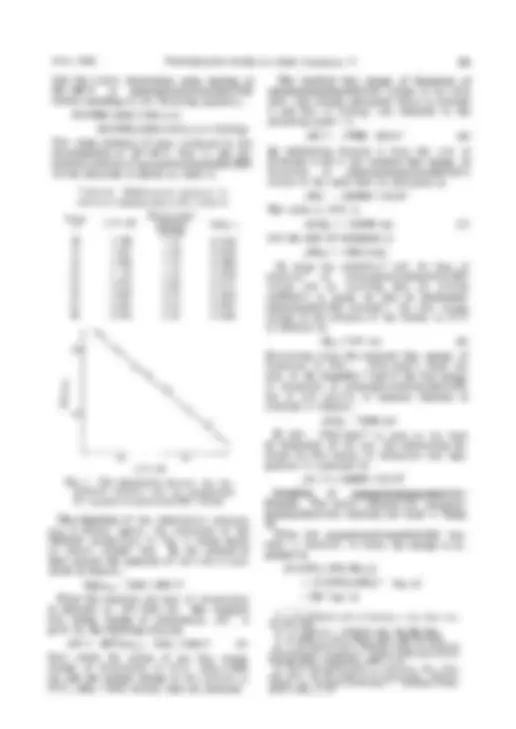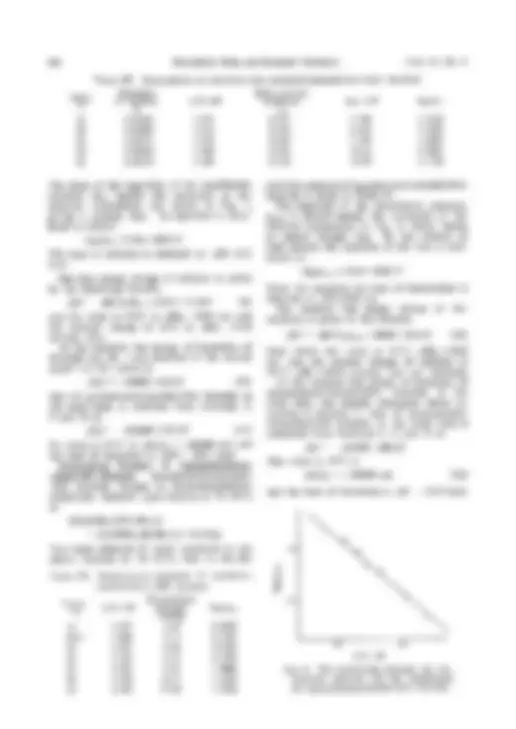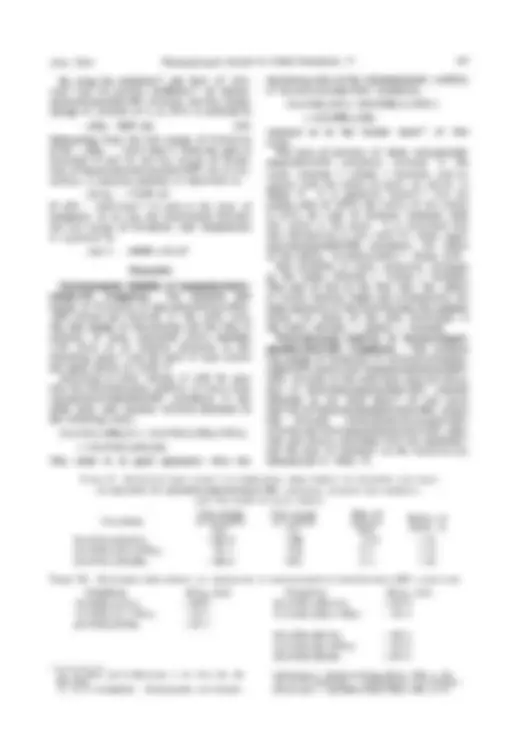





Study with the several resources on Docsity

Earn points by helping other students or get them with a premium plan


Prepare for your exams
Study with the several resources on Docsity

Earn points to download
Earn points by helping other students or get them with a premium plan
Community
Ask the community for help and clear up your study doubts
Discover the best universities in your country according to Docsity users
Free resources
Download our free guides on studying techniques, anxiety management strategies, and thesis advice from Docsity tutors
the Thermal Dissociation of Aquopentamminecobalt (III) Nitrate and Bromide, and on the Thermodynamic Stability of. Monoacidopentamminecobalt(III) Complexes*.
Typology: Study notes
1 / 6

This page cannot be seen from the preview
Don't miss anything!




June, 1'9601 Thermodynamic Studies in Cobalt Complexes. V 841
In the preceding papery the authors deter mined the standard free energies of formation of aquopentamminecobalt (III) chloride in the solid state and in aqueous solution. In the present study the standard free energies of formation of aquopentamminecobalt(III) nitrate .and bromide in the solid state were determind by measuring their solubilities, and those of nitratopentamminecobalt(III) nitrate and bromo- pentamminecobalt(III) bromide in the solid :state were determined by measuring their dis- sociation pressures. On the basis of these data the thermodynamic .stability of aquopentamminecobalt(III) chloride, nitrate and bromide, that of monoacidopent- ) amminecobalt(III) complexes and that of their ions in aqueous solution were compared and .discussed.
Experimental
Aquopentamminecobalt (III) nitrate was preci- pitated with nitric acid from an aqueous solution of its chloride. The bromide was prepared by the .double decomposition of its chloride with ammoium bromide in aqueous solution. Solubilities of these aquopentamminecobalt(III) .complexes were obtained by analyzing the cobalt .content in their saturated solutions by iodometry in the same manner as described in the second paper2) of this series. The dissociation pressures of the .complexes were measured with the same apparatus ,as described in the third paper3).
Results and Calculation
Solubility of Aquopentamminecobalt (III) Nitrate.-The results obtained for aquopent- amminecobalt(III) nitrate are listed in Table I. As the activity coefficient of the compound was not known, it was assumed that it was approximately equal to that of hexammine- cobalt(III) chloride4) in relatively lower con- centrations. When aquopentamminecobalt(III) nitrate is dissolved in water, the change is expressed by
If the solubility of the salt in molality and its mean activity coefficient are expressed by m and rf respectively, the equilibrium constant
Fig. 1. The relationship between the equili- brium constant of the solution and the temperature.
842 Motoshichi MORI and Ryokichi TsucxtnA [Vol. 33, No. 6
TABLE I. EQUILIBRIUM OF SOLUTION FOR AQUOPENTAMMINECOBALT(III) NITRATE
of the solution, KNO3,is given by
The plots of its logarithm against the reci- procal of the absolute temperature are shown in Fig. 1, giving an almost straight line. Its equation computed by the method of least squares is
On the other hand, the standard free energy of formation of the aquopentamminecobalt(I11)
ion in unit activity was calculated in the preceding paper1) as (2) and that of the nitrate ion, N03-, was obtained in the second paper2) of this series as
(3) From formulae 1, 2 and 3, the standard free energy of formation of aquopentamminecobalt- (III) nitrate in the solid state is calculated as. (4)
Dissociation Pressure of Aquopentammine cobalt (III) Nitrate.-The weight loss of aquo-- pentamminecobalt(III) nitrate upon heating was followed by a thermobalance. The relationship between the weight loss and the temperature is plotted in Fig. 2, together with those of aquopentamminecobalt(III) bromide, chloride and perchlorate. It is found in this figure:
Fig. 2. The relationship between the weight loss and the temperature upon heating for several aquopentamminecobalt (III) complexes by a thermobalance.
-; aquopentamminecobalt(III) chloride ; aquopentamminecobalt (III) sulfate hydrate ; aquopentamminecobalt (III) perchlorate
844 Motoshichi MORI and Ryokichi TSUCHIDA [Vol. 33, No. 6
TABLE III. EQUILIBRIUM OF SOLUTION FOR AQUOPENTAMMINECOBALT(III)BROMIDE
The plots of the logarithm of the equilibrium constant, KB,, against the reciprocal of the absolute temperature are shown in Fig. 1,
giving a straight line. Its equation is calcu- lated as follows
The free energy change of solution is given by the following formula,
(9)
entropy unit. As the standard free energy of formation of bromide ion, Br-, was obtained in the second paper2) of this series as (10) that of aquopentamminecobalt(III) bromide in the solid state is obtained from formulae 2, 9 and 10 as: (11)
Dissociation Pressure of Aquopentammine- cobalt (III) Bromide.-Aquopentamminecobalt- (III) bromide changes to bromopentammine-
The vapor pressure of water produced by the above reaction at 18•`32•Ž, that is, the dis-
TABLE IV. DISSOCIATION PRESSURE OF AQUOPENT- AMMINECOBALT(III) BROMIDE
sociation pressure of aquopentamminecobalt (III) bromide is listed in Table IV. The logarithm of the dissociation pressure, pmm,is plotted against the reciprocal of the absolute temperature in Fig. 4, which shows an almost straight line. By the method of least squares the equation of this line is com- puted as:
The standard free energy change of dis- sociation is given by the formula,
(12)
As the standard free energy of formation of aquopentamminecobalt (III) bromide in the solid state was already calculated above ac- cording to formula 11, that of bromopentam- minecobalt(III) bromide in the solid state is calculated from formulae 6, 11 and 12 as
(13)
Fig. 4. The relationship between the dis- sociation pressure and the temperature for aquopentamminecobalt(III) bromide.
June, 19601 Thermodynamic Studies in Cobalt Complexes. V 845
By using the solubility5), the heat of solu- tion6) and the activity coefficient7) of bromo- pentamminecobalt (III) bromide, the free energy
Subtracting twice the free energy of formation
formulae 13 and 14, the free energy of forma- tion of bromopentamminecobalt(III) ion in unit activity in aqueous solution is calculated as:
formation of its ion, the relationship between the free energy of formation and temperature is expressed by
Discussion
Thermodynamic Stability of Aquopentammine- cobalt (III) Complexes.-The standard free energy of formation of aquopentamminecobalt- (III) nitrate and bromide in the solid state, the free energy of the solution and the heat of solution of them calculated above together with those of its chloride obtained in the preceding paper1) and the radii of each anions are again shown in Table V. According to these values, it will be seen that the thermodynamic stability of these three aquopentamminecobalt(III) complexes in the .solid state and aqueous solution decreases in the following order,
This order is in good agreement with the
decreasing order of the thermodynamic stability of hexamminecobalt(III) complexes, [Co (NH3) 61C13> [Co (NH3) 61(NO3) 3
[Co(NH3)61Br reported as in the second paper') of this series. The heat of solution of these aquopentam- minecobalt(III) complexes increases in the order, chloride < nitrate < bromide, and in- creases with the radius of anion as shown in Table V. It is generally known12) that for simple salts of which the radius of the cation is 2.4A, the heat of solution increases with the radius of the anion. It is concluded that this relationship is also valid for these aquo- pentamminecobalt(III) complexes, the radius of the cation, [Co (NH3) 5OH2] 3+, being 2.4A. The solubility of these complexes decreases in the order, chloride > nitrate > bromide. This may be due to the fact that the radius of anions becomes larger and consequently the ionic character of the bond between the complex cation and anion of the salts diminishes in the order, chloride > nitrate > bromide. Thermodynamic Stability of Monoacidopent- amminecobalt (III) Complexes.-The standard free energy of formation of nitratopentammine- cobalt(III) nitrate and bromopentamminecobalt- (III) bromide in the solid state obtained above, that of chloropentamminecobalt(III) chloride obtained in the third paper 3) of this series and that of chloropentamminecobalt(III) nitrate and bromide, nitratopentamminecobalt (III) chloride and bromopentamminecobalt(III) chlo- ride and nitrate calculated from the solubility') and the heat of solutions) in the literature are summarized in Table VI.
TABLE V. STANDARD FREE ENERGY OF FORMATION, FREE ENERGY OF SOLUTIONAND HEAT , OF SOLUTIONOF AQUOPENTAMMINECOBALT(III)CHLORIDE, NITRATE AND BROMIDE, AND THE RADII OF EACH ANIONS
TABLE VI. STANDARD FREE ENERGY OF FORMATION OF MONOACIDOPENTAMMINECOBALT(III) COMPLEXES
verbindungen ", Akademie-Verlag, Berlin (1956), p. 178.